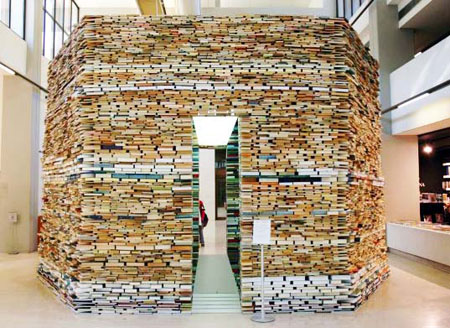The idea of the book, continued some more
Posted Under: Things/Thinking
A bit late on this, but over the weekend Virginia Heffernan’s column was a consideration of physical books by a professed ebook fan. Jumping from Walter Benjamin’s “Unpacking My Library: A Talk About Book Collecting,” which rhapsodizes about the the amassing even of books you never read, she writes:
If he says not reading books can be as sophisticated and European as reading them, I believe him, and I will try to think of my books as Sèvres china. But Sèvres china, if I had any, would be for display on its days off, wouldn’t it? So how do I display or otherwise admire all these books I keep buying for the Kindle?
Unpacking my Kindle library, I click “menu” on my screen and find . . . a list. First, the words “The Happiness Project,” the title of a book by Gretchen Rubin, in stout dark gray lettering, underscored by a lighter, less stout line.
This might be depressing. I can’t tell if I’m supposed to consider this underlined title to be the “book” I ordered from Amazon. Maybe it’s more like a catalog listing. If I click on it, I’ll get to the words in the book. Maybe it’s analogous to a book’s spine.
I want to rhapsodize, as Benjamin does, when he remembers the tactics he employed to acquire the book “Fragmente aus dem Nachlass eines jungen Physikers” (Johann Wilhelm Ritter, 1810) after a Berlin auction. But the only memory I have of purchasing “The Happiness Project” is no memory at all….
Read the rest here. It’s interesting. See also if you missed it the Murketing post on book spines as wallpaper, here.
On a slightly related note, I offered some examples a while back of artists and designers making things out of books in a post on Significant Objects. Two more examples here: the one above by Paul Octavious, via SwissMiss, and the other by Matej Kren, below, via Book Of Joe.




 "
"














 Kim Fellner's book
Kim Fellner's book  A
A
Reader Comments
Steve L sends along two book-art-related videos:
http://vimeo.com/6946442
http://vimeo.com/7136290
If you’re into that sort of thing.
Here in Houston, the Rice University library has an installation made of old books with their spines facing out and painted on, lining the walls. I think it sends an ambiguous message, especially in that context–on the one hand, books are to be celebrated and displayed; on the other hand, they are to be treated as objects rather than read. The same ambiguities apply to the other works you show above. This is interesting in light of your mention of the Kindle. Books seem to be viewed as obsolete and are being downcycled into mere building material.
Rebecca, I couldn’t agree more.